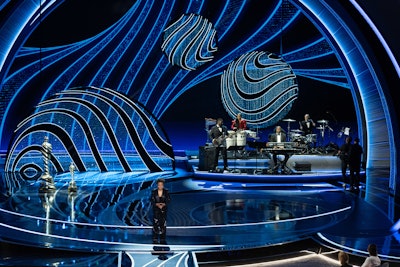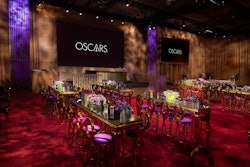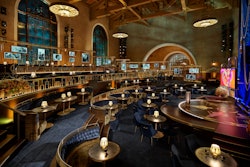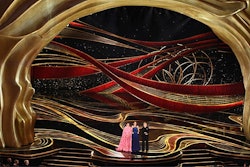
LOS ANGELES—It was meant to be a return to form after last year’s intimate, socially distanced ceremony. But as anyone who read a headline on Monday morning knows, the 94th Academy Awards will likely not be remembered for the electrified stage design, the extensive COVID protocols or the history-making Best Picture win for CODA.
Instead, the immediately infamous slap—when eventual Best Actor winner Will Smith came on stage to strike presenter Chris Rock after the comedian made a joke about the actor’s wife, Jada Pinkett Smith—is what everyone was buzzing about the morning after.
But the ceremony—which took place March 27 at the Dolby Theatre in Hollywood and was televised live on ABC—had plenty of other memorable moments, from hosts Regina Hall, Amy Schumer and Wanda Sykes' playful banter, to a milestone win for deaf actor Troy Kotsur, to a live performance of Encanto hit "We Don’t Talk About Bruno." Directed by veteran head Glenn Weiss, the show was produced by Will Packer in his first involvement with the Oscars. Production designer and creative director David Korins handled the stage design again this year, after a previous outing at the 2019 show.
As one of the country's most high-profile—and high-budget—gatherings, many event producers watch the ceremony looking for inspiration. BizBash caught up with five of them, asking them to review the set, the programming and more with their expert eyes. Scroll down to read their thoughts.  Other elements of the stage design included what Korins described on Instagram as "the wave." "The wave embodies so many themes of the evening—it's architectural, soft, poetic, organic and adorns the stage like a piece of jewelry," Korins wrote.Photo: Blaine Ohigashi / A.M.P.A.S.
Other elements of the stage design included what Korins described on Instagram as "the wave." "The wave embodies so many themes of the evening—it's architectural, soft, poetic, organic and adorns the stage like a piece of jewelry," Korins wrote.Photo: Blaine Ohigashi / A.M.P.A.S.
Allison Pieter
Letter Grade: B
What a difference a year makes! The Oscars returned to the Dolby Theatre in grand Hollywood style. Will Packer promised the night wouldn’t be boring, and he was certainly correct!
The stage and production design were stunning—very bright, clean and modern. The rich reds and deep blues first seen on the red carpet with floral accents were boldly carried throughout the many looks on the stage. I love how it transformed multiple times throughout the night, first with supersized curls, then sparkly spheres and then again with illuminated triangles. I imagine the set designers had a great time creating all these looks! One pandemic-era design that seems destined to stick around is the cabaret-style seating, providing the nominees with a more intimate setting (and extra legroom!) while giving the cameras a more dynamic wide shot.
The use of three hosts went over better than I anticipated. All three women are very funny in their own right, and once they found their footing, they fearlessly went to some entertaining places. From Regina Hall’s running jokes about being single, to Amy Schumer flying in as Spider-Man, to Wanda Sykes dressing as King Richard, I thought the hosts were used strategically to provide moments of levity without overstaying their welcome. I love how they closed the show in their pajamas—a quick, pointed laugh to end the long night.
While I appreciate the producers’ efforts to celebrate cinema, the segments provided mixed results. There was simply too much packed into the show. The James Bond montage was a great reminder of why people love cinema, and celebrating the anniversaries of iconic films such as The Godfather and Pulp Fiction provided a fun vehicle to bring presenters to stage. Kudos to the team for the Liza Minnelli and Lady Gaga pairing—what a lovely moment! Other elements, such as the top five movie moments and the Chris Evans in-show commercial, fell flat and simply added to the length of the already over-extended broadcast. The non-live segments were integrated fairly well into the show; however, with the broadcast already so over time, would another few minutes have made much of a difference? I’m not sure the updates were worth alienating so many participating members.
Diversity was front and center this evening. We saw historic wins by a queer Afro-Latina for Best Supporting Actress, a deaf man for Best Supporting Actor and the first Latina producer to win an Academy Award. What a pleasure to see the winners and presenters better reflect the world in which we live! When watching the almost joyful gospel celebration for the In Memoriam performance, I was reminded how the perspective of a Black producer and production team breathed new life into this usually tired segment. Live ASL interpretation was available on the Academy’s YouTube channel; I wish it had been onscreen for all categories, in addition to being available as needed for attendees.
No review would be complete without addressing the Will-ephant in the room. From a live production point of view, it is a good reminder to have back-up plans upon back-up plans, as anything can (and sometimes does) happen. The producers seemed ill-prepared for the moment; perhaps going to the logo or sending one of the hosts on stage would have been better options than watching the two argue. Unfortunately, this moment will be the headline everyone remembers.
With the stakes higher this year, and the ever-present challenges of relevancy, timing and inclusion still front and center, overall the producers delivered a solid show.
Allison Pieter is the founder and president of Cassis Productions, an event consultancy and production company based in Los Angeles. She has produced events for companies and organizations such as Hulu, Freeform, Universal Pictures, Dreamworks, McKesson, California Department of Education, UC San Francisco and iHeartMedia.
Jon Retsky
Letter Grade: C
I’m a little bit confused—and it’s not about whether or not the Will Smith thing was real.
The technology utilized for this year’s design was striking, dynamic and refreshing. The future-forward electric design (literally) brought us illuminated stage floors, electrified cabaret tables, kinetic illuminated set pieces, a gorgeously lit proscenium, radiating channels throughout the theater and glowing Oscar statues. It felt like just about every single element of the set was glowing or electrified in some fashion, and as a lighting designer, that’s an A+++++ in my book! All of these elements alone were architecturally balanced, striking, innovative and certainly a leap in design from prior years.
But all of these items together were wildly distracting, busy and confusing. Amidst this chaos, the story of the design just didn’t make sense and the “through-line” (something discussed often throughout the night) just didn’t seem there. At first, I thought the changing sets were a nod to the style of each of the nominated Best Pictures. At the time of writing this, I’m still not sure why the set changed so dramatically and what story it was trying to tell. Beautiful, yes. But what story was it trying to tell its audience?
I was impressed with how the set design made the giant, cavernous Dolby Theatre feel intimate by implementing an encircled proscenium and cabaret-style seating for a portion of the audience. The sweeping illuminated lines of the proscenium itself were gorgeously designed and crafted. There were some really striking, beautiful, clean moments throughout the evening. However, any time a scenic element came into play upstage, it made the entire look chaotic, dizzying and somewhat excessive.
To make matters worse, but certainly on-brand for the chaotic distraction theme of the night, the In Memoriam was a low moment for the Oscars this year. I applaud the designers and producers for stepping out of the normally sullen read-off of recently deceased Hollywood talent amidst a cacophony of melancholy violins. In fact, I thought the upbeat score was refreshing and on point. But having dancers on stage (often blocking the screen) during all of this was so incredibly distracting and a little bit disrespectful. At the end of it all, I actually missed the melancholy strings.
I did love the concept of the illuminated “A’s” that tied in so beautifully with the on-screen graphics and lower thirds. Their fluid movement across the stage was sexy and smart. But again, even those got a little busy to look at. There were just too many of them! Maybe just one set of “A’s” and one illuminated Oscar flanked by the stunning proscenium would’ve created a more striking look.
All in all, while all the design elements were there, the lack of editing feels like a slap across the face.
Jon Retsky is co-founder and lead lighting designer at Got Light, a San Francisco-based event design team working on some of the Bay Area’s biggest events for clients like the San Francisco Ballet, SF MoMa, SF Symphony, SF Opera and more. Retsky has a background in architectural and theatrical lighting design.
Jamie D'Attoma
Letter Grade: A-
Well, this year’s Oscar ceremony will undoubtedly be one for pop culture history. But despite the “slap heard 'round the world,” the show was stacked with three hilarious hosts, heartfelt speeches, breathtaking musical performances and a slew of iconic and nostalgic cast reunions that helped drive home this year’s theme of “Movie Lovers Unite.”
Following the past few years of not having a host, it was a risk to have not one or two but three sharing the title this year. Hall, Schumer and Sykes were a dynamic trio with a relatively equal amount of airtime, and jokes that got laughs, but did not go overboard. It’s also worth mentioning with the Golden Globes canceled this year (zinger material Schumer shared during her opening monologue), it seemed as though Oscars organizers wanted to showcase this was the year they were going to “let their hair down” and not be the stuffy or dragged-out show it has a reputation of being.
This was further demonstrated with the set design, lighting and staging. For example, this year's seating was less formal and more lounge-like with “VIP” banquette-style seats, complete with DJ D-Nice spinning before commercial breaks. Even the In Memoriam paired the video montage with an uplifting gospel-style musical medley—a lighter tone to the more somber segments from previous years.
All of the musical performances were thoughtfully placed throughout the ceremony, helping to keep a lively pace and infuse vibrancy onto the stage. It was a brilliant choice to open with Beyonce’s “Be Alive” performance from the film King Richard. If Beyonce performing clad in a tennis-ball-green gown from a tennis court in Compton wasn’t captivating enough, the all-female matching ensemble and camera pans of sweeping aerial views served as a striking prologue to the rest of the show inside the Dolby Theater. Outside of the performances, the lighting resets from royal red to cool blue to Oscar gold also helped break the show into digestible segments for the viewer at home.
Not factoring in the shock value that came two-thirds of the way in, and despite some clunky editing of awards that were handed out earlier in the night, this year’s ceremony was certainly anything but boring.
Jamie D'Attoma is the executive vice president and partner at SHADOW, a creative marketing and communications agency with integrated disciplines across media relations, influencer marketing, experiential and event production, social media management and content development.
Keri Miller
Letter Grade: B
Firstly, kudos and much respect to the producers and crew of the 94th Oscars production and broadcast. After what I can only imagine was a year of zig-zag planning and contingency efforts, they technically (and I’m assuming exhaustingly) pulled it off. Obviously, there are many things we can comment on, but as an event professional and a human, I struggled reviewing the show.
Getting the call to produce and design this show must be both elating and terrifying, and [Sunday] night is proof of why. It felt like a tug of war between what could have been a bright, new, shiny, future-forward Oscars against the traditional check-the-boxes, politically charged objectives of the Academy. I envision embattled meetings where the producers were boldly challenging the status quo, embracing inclusivity and accessibility, designing in the “now,” against the powerful forces of the Academy, the pandemic and a declining, aging audience—all while being strangled by the ever-changing global landscape.
The production combined a brilliant stage and lighting design with unique attempts at contemporizing the hosting, the In Memoriam and the entertainment segments. The lighting design was outstanding, and the "We Don’t Talk About Bruno" performance brought it to life spectacularly. I loved the myriad of stage looks and transitions, the multiple layers for camera shots and the expansion of the design into the seating. [But] the attempt at inclusive seating ended up feeling isolating and after two years of it, why couldn’t families join the elite nominees up front? If it wasn’t a COVID-restrictive decision, it was a missed opportunity for connection, authenticity and human energy.
The pre-recorded segments and transitions were a bit clunky and confusing, and the walk-off for the first few recipients was the same. It was disappointing to have some acceptance speeches cut short to allow time for an ad for the Academy Museum. This is an awards show, and it felt like the awards were not the priority. I liked the reflection on past films and using their status and stars to present the awards, a great connection while honoring the art itself. The hosting piece felt a bit like an audition for all three of the talented women, I was surprised at how well they did together versus their solo segments. It felt like each of them was not trusted to do the job on their own—and yet it also felt like they were being pre-protected from potential or expected failure. I loved Amy’s timing, one-liners and punchy political hits; I’m a fan.
Overall, it was beautiful and technically sound, but the evening felt awkward and forced to me even before the “moment that shall not be named.” I do not believe this to be a reflection on the production itself, but in the strange belief that the world could “just go back to the way it was” without considering the emotional, mental and perhaps fragile state of the humans involved.
Congrats to the producers; they were very clever and purposeful in their visuals and quiet storytelling. I’d like to believe that the brilliant, illuminating, simple and inspiring final look on stage was a symbolic nod to where the producers would love the Oscars to be in 2023.
Keri Miller is partner and chief creative strategist for e=mc² events, an event management company with offices in Toronto, Vancouver and Calgary. Miller leads strategic, creative and marketing initiatives for the company, which handles live experience design, management and production for clients around the world.
Naomi Ratner Oshry
Letter Grade: B
I thought the 94th Academy Awards was a well-produced celebration of movies with a nice set, strong lighting design and key moments to surprise and delight guests—whether or not they were planned.
Experiences need to grab people’s attention—whether they’re IRL or on screen—and kicking off with a performance by Beyonce got viewers excited about the rest of the evening. The show did its best to appeal to a variety of audiences with multiple hosts, varied performances and highlights of movie anniversaries keeping viewers engaged.
Every moment of an experience should have a purpose, and not every moment during this award show did—DJ Khaled’s moment felt unnecessary, as did Amy Schumer’s Spider-Man costume, among others.
Overall, the production was well-rehearsed, aside from the only-on-live-television moment with Chris Rock and Will Smith. Although unplanned, some drama always keeps things exciting and keeps people talking, long after the experience is over. With that said, if someone missed the Oscars, I don’t think they need to run to their DVR to watch tonight.
Naomi Ratner Oshry is the director of business development and communications for 3CS, a production-focused experiential marketing agency based in San Diego. She’s been working in the experiential industry since 2010, bringing projects to life for clients around the world.



















